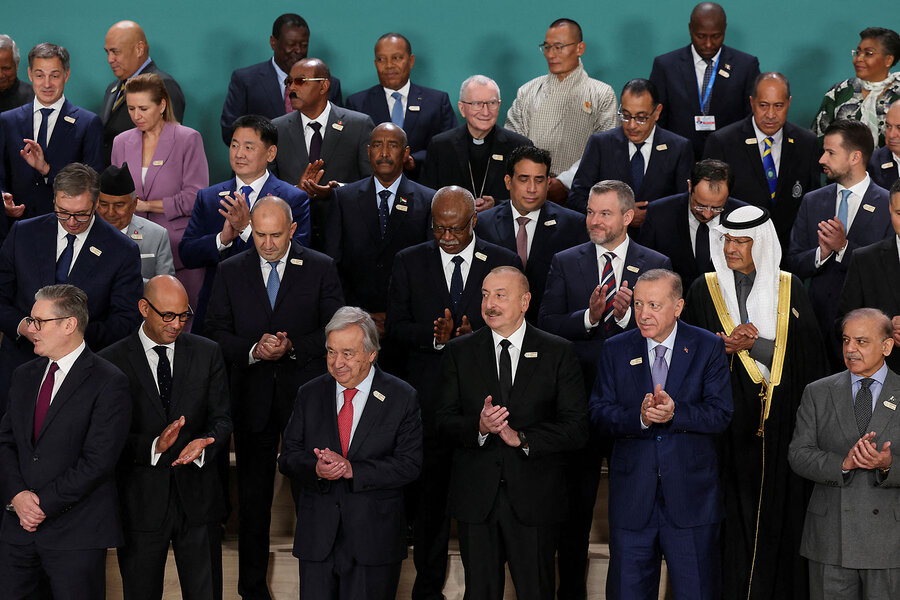
World diplomats are gathered in Baku, Azerbaijan, trying to make some progress on what many see as the trickiest part of combatting climate change: paying for it. For 29 years now, these policymakers – along with tens of thousands of advocates, academics, industry executives, and other onlookers – have gotten together for an annual COP, or “Conference of the Parties,” to make big collective decisions about what to do about global warming. The process has led to some remarkable consensus-building; 195 countries have agreed to try to limit global warming to 1.
5 degrees Celsius. They have promised to phase out fossil fuels and stop deforestation by 2030, and they have decided that wealthy countries – those most responsible for Earth’s warming – should financially help developing nations adapt and deal with the impacts of climate change. But turning these goals into reality is an immense challenge, one that even supporters of international diplomacy say may require a new approach.

Despite the pledges, greenhouse gas emissions are still on the rise. And the global price tag for slowing and adapting to climate change is breathtakingly high, with some estimates putting it at more than a trillion dollars a year. World diplomats are gathered in Baku, Azerbaijan, trying to make some progress on what many see as the trickiest part of combatting climate change: paying for it.
For 29 years now, these policymakers – along with tens of thousands of advocates, academics, industry executives, and other onlookers – have gotten together for an annual COP, or “Conference of the Parties,” to make big collective decisions about what to do about global warming. The process has led to some remarkable consensus-building; 195 countries have agreed to try to limit global warming to 1.5 degrees Celsius.
They have promised to phase out fossil fuels and stop deforestation by 2030, and they have decided that wealthy countries – those most responsible for Earth’s warming – should financially help developing nations adapt and deal with the impacts of climate change. But turning these goals into reality is an immense challenge, one that even supporters of international diplomacy say may require a new approach. The election of Donald Trump in the United States adds another variable; he pulled out of the 2015 Paris climate agreement and many have speculated that he may do so again.
Despite the pledges, greenhouse gas emissions are still on the rise. And the global price tag for slowing and adapting to climate change is breathtakingly high, with some estimates putting it at more than a trillion dollars a year. (At the same time, it’s important to point out that many climate advocates argue that the cost of not reacting to global warming is even more jaw-dropping.
) This issue of “climate finance” is front and center at this year’s COP. And it gets complicated quickly. One big question that diplomats are debating is how much money wealthy countries should send to developing nations to help with their climate transitions.
In 2009, for instance, wealthy countries promised to send an annual $100 billion in climate finance. Now developing countries are asking to raise that to $1.3 trillion.
It’s a huge jump from the last commitment because, as Lisa Sachs, director of Columbia University’s Center on Sustainable Investment points out in an email, the $100 billion was “always too low relative to the true costs of climate action – including the costs to transition the world’s energy, transportation and industrial sectors, as well as to build resilience to more frequent and more extreme weather events.” Still, it’s a number most wealthier countries say is likely unfeasible. But at the same time, they are looking at another force in financing to help – the private sector.
This is also complicated. But it’s arguably one of the more interesting and optimistic aspects of climate action today. Over the past few years, clean energy has evolved into one of the biggest economic growth sectors around the world.
Clean energy was a primary driver of China’s economic growth last year, according to the Centre for Research on Energy and Clean Air, and the sector is growing exponentially around the world, according to the International Energy Agency. In the U.S.
, the clean-energy sector saw a job growth rate of 4.2% in 2023, compared with an already strong 2% growth rate in the overall economy, according to the U.S.
Department of Energy. “Unlocking” private capital to flow into developing countries could both help pay for the world’s climate change response and be an economic boon, some say; a win for both business and global equity. Others in the climate world are doubtful.
“Private finance has multiple issues,” says Ivana Vasic-Lalovic, senior research associate at the Washington-based Center for Economic and Policy Research. “It’s a lot more expensive for countries ..
. and by handing over the control of these climate projects the state can lose out.” Many in the business world are acutely focused on this year’s COP because they are hoping for a more stable global regulatory environment, as well as government investment they say could supercharge innovation.
Different types of funding mechanisms and carbon taxation plans are also on the agenda. With all of this complexity, some longtime COP supporters are suggesting that the annual meeting is due for an overhaul, to prompt less talking and more doing. On Friday, more than a dozen prominent climate change officials, including Ban Ki-Moon, former United Nations secretary-general, and Christiana Figueres, the former executive secretary of the United Nations Framework Convention on Climate Change, called for a revamp of the COP process.
“Its current structure simply cannot deliver the change at exponential speed and scale, which is essential to ensure a safe climate landing for humanity. This is what compels our call for a fundamental overhaul of the COP,” they wrote. “We need a shift from negotiation to implementation.
”.














